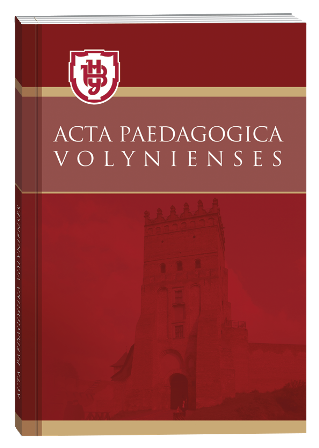DOMINANTS OF THE FUNCTIONAL DIRECTION OF THE EDUCATIONAL ENVIRONMENT OF THE PRESCHOOL
DOI:
https://doi.org/10.32782/apv/2025.1.8Keywords:
educational environment of the educational institution, innovative technologies, personal, organizational activity, subject-spatial component of the educational environment, pedagogy of partnership, free choice of activityAbstract
The article highlights the main aspects of the functional direction of the educational environment of the ZDO.The relevance of the stated problem in the context of dynamic changes in education in Ukraine at the present stage is emphasized. The purpose of the article is specifically defined, the analysis of scientific research is carried out. On the basis of the generalization of scientific developments, the interpretation of the concepts of “educational environment” and those close to it, namely: “global educational environment”, local educational environment, “educational space”, is substantiated.Its own interpretation of the category of “educational environment of the preschool” is presented, its components are singled out: personal component, subject-spatial, organizational activity. The conditions for their implementation have been determined. It is noted that the educational environment of ZDO is a multifaceted, multifunctional system that needs constant improvement. The leading principles of the functioning of the educational environment of the preschool are highlighted: individualization, partnership, universality, openness. The characteristics of the latest technologies and methods that contribute to the implementation of all components of the educational environment of the ZDO are presented. The importance of creating conditions for ensuring all types of activities of a preschooler in the educational environment for the purpose of full development of the personality is emphasized. The relevance of the implementation of partnership pedagogy was noted. The expediency of using innovative pedagogical and information and communication technologies is emphasized. The emphasis is placed on the need to provide preschoolers with the opportunity to freely choose the type of activity, determine the degree of participation in it, and the ways of its implementation. The effectiveness of the outlined innovations in the process of revealing the personal potential of pupils has been proved. Balanced conclusions and prospects for researching the stated problem are outlined.
References
Андрющенко Т. К. Формування у дошкільників здоров’я-збережувальної компетентності (старший дошкільний вік): методичний посібник. Тернопіль : Мандрівець, 2016. 120 с.
Базовий компонент дошкільної освіти. Вихователь-методист дошкільного закладу. 2012. Спецвипуск. С. 1–29.
Богуш А. Методика ознайомлення дітей з довкіллям у дошкільному навчальному закладі. Підручник для ВНЗ / А. М. Богуш, Н. В. Гавриш. К. : Видавничий Дім «Слово», 2010. 408 с.
Богуш А. М. Компетентнісний підхід до мовленнєвого розвитку дошкільників. Педагогічна наука в Україні: до 15-річчя АПН України. АПН України. К., 2007. Т. 2 : Дидактика, методика, інформаційні технології. К., 2007. С. 155–170.
Гонтаровська Н. Б. Теоретичні і методичні засади створення освітнього середовища як фактору розвитку особистості школяра : дис. ... док. пед. наук : 13.00.07 / Гонтаровська Наталія Борисівна. К., 2012. 475 с.
Крутій К. Едьютейнмент: навчання як розвага. Дошкільне виховання. 2017. № 1. С. 2–6.
Концепція Нової української школи. [Електронний ресурс] Режим доступу: https://mon.gov.ua/static-objects/ mon/sites/1/zagalna%20serednya/nova-ukrainska-shkola-compressed.pdf
Крутій К. Технологія «Стіни, які говорять», або своєчасне перетворення освітнього простору дошкільного навчального закладу. 2019 [Електронний ресурс]. Режим доступу: https://jmil.com.ua/dv/2019-1/p3
Крутій К. Освітній простір дошкільного навчального закладу: [монографія] : у 2-х ч. К. : Освіта 2009. Ч. 1. 302 с.
Ковальчук В. А. Проблема дослідження виховних систем загальноосвітніх закладів. Вісник Житомирського державного університету імені Івана Франка. 2008. Вип. 41. С. 50–53.







